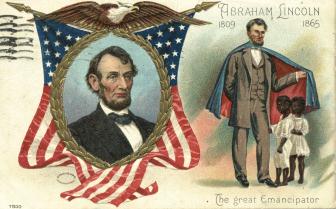 |
AfrolumensProject Central Pennsylvania African American History for Everyone Twenty-six years on the web 1997 - 2023 |
|
|
Allegorical Imagery in Lincoln Centennial Postcards
|
 Another
in this theme is “The Great Emancipator” in the Lincoln Series issued
by Julius Bien Company of New York City (figure 6, right).
Instead of a liberator role, however, the president assumes the
role of protector as he shelters two small slave children under his
mantle. The paternal image
recalls the title “Father Abraham,” used affectionately especially by
Blacks in reference to the president during the war.
It also stands in contrast to the previous Nash image of
liberation, wherein slaves are encouraged to rise and stand shoulder to
shoulder with whites in a government “without a Master and without a
Slave.” Bien’s image, in
symbolizing Blacks as children, seems to suggest a view, common at the
time, that Blacks were not yet able to assume full responsibilities in
American society, and were in need of white guidance. Another
in this theme is “The Great Emancipator” in the Lincoln Series issued
by Julius Bien Company of New York City (figure 6, right).
Instead of a liberator role, however, the president assumes the
role of protector as he shelters two small slave children under his
mantle. The paternal image
recalls the title “Father Abraham,” used affectionately especially by
Blacks in reference to the president during the war.
It also stands in contrast to the previous Nash image of
liberation, wherein slaves are encouraged to rise and stand shoulder to
shoulder with whites in a government “without a Master and without a
Slave.” Bien’s image, in
symbolizing Blacks as children, seems to suggest a view, common at the
time, that Blacks were not yet able to assume full responsibilities in
American society, and were in need of white guidance. |
|
The
card in figure 7 is a much more complex rendering of the liberator theme.
Illustrated by Cyrus Durand Chapman (whose distinctive style is
recognizable in figure
1) for International Art Publishing Company, it is
dominated by the figure of Liberty holding the federal shield in one hand and
a liberty pole, surmounted with a Phrygian, or liberty cap. An eagle, laurel leaves, and other patriotic motifs are at her side.
Inset is a view of the Emancipation Memorial, sculpted by Thomas Ball
and dedicated in Washington in 1876. The memorial depicts Lincoln in much the same pose as in the Nash view, standing over a kneeling, chained slave who is in the motion of rising. The president holds an open copy of the Emancipation Proclamation. The slave in this statue actually depicts a historical person, Archer Alexander, said to be the last slave captured under the Fugitive Slave Act of 1850. |
|
To the modern observer, it may seem that these early twentieth century postcard artists were attempting to crowd too much symbolism onto a three-inch by five-inch canvas, and that surely the people who sent and received these cards did not understand all of the symbolism, allegorical meaning and political undertones present on a simple view of the sixteenth president. But we must remember the importance of symbolism and subtlety to this period in history, when life’s slower pace allowed people to study illustrations closely. Indeed the enjoyment and study of illustrations, pictures, prints and paintings were a chief source of leisure activity. The average working person certainly understood the classical and
national symbolism present in Lincoln Centennial postcards, and sent,
received and collected them not only because they liked the pictures of
“The Martyred President,” but also as a way of participating
in the national movement to pay homage to the man.
It did not matter that these images did not hang in an art
gallery, or that they could be bought cheaply.
Their significance lay with the intent of the users—common,
working people—as a tribute to a beloved American hero. The author wishes to thank James Schmick of Civil War and More, Mechanicsburg, PA, for the use of the postcards in this series. |
Afrolumens Project Home | Slavery | Underground Railroad | 19th Century | 20th Century
Original
material on this page copyright 2003-2023 Afrolumens Project
The url of this page is http://www.afrolumens.com/rising_free/lincolnpc4.html
Contact the editor [email protected]
This page was updated March 15, 2023.